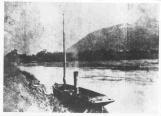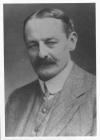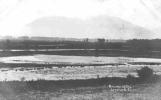1
Events of the summer of 1882 would have a lasting impact on the development of the Kootenay region. Primarily, numerous rich silver, iron, and lead deposits were discovered, triggering a mining boom that led to the establishment of an industry, several communities, and transportation systems, that remain to this day. In comparison, the arrival of William-Adolph Baillie-Grohman, in search of a big-horn sheep trophy for his wall, seems a very inconsequential thing.3
"W. A. Baillie-Grohman an English gentleman adventurer. He first saw the valley in the fall of 1882. In 1883 he went up the river to Canal Flats."- Bill Constable
5
"I had commenced negotiations with the Government of British Columbia with the object of obtaining a concession for an extensive tract of land lying between the boundary line and Kootenay Lake. This land, some 48,000 acres in extent, consisted of level alluvial bottoms lying on both sides of the river. Of their high value as agriculture land there could be no doubt, provided the overflow (lasting about six or eight weeks), to which they were subject every summer, could be stopped."- William-Adolph Baillie-Grohman, as read by John Hopcraft
6
Bill Constable explains BaillieGrohman's scheme to divert the Kootenay River at Canal Flats.1883
Canal Flats, BC

7
"He [Baillie-Grohman] was conversant with the physical geography of the Kootenay and the Columbia River systems, and at one point the Kootenay is less than a mile away from the Columbia Lake and that is right at Canal Flat. And there was a drop of eleven feet between where the Kootenay was and the lake. He conceived the idea of diverting the Kootenay River into the Columbia at this point. His engineers and the provincial government agreed that the scheme was practical."- Bill Constable
Baillie-Grohman and the provincial government agreed that he would build the canal between the two waterways, in exchange for the tract of land south of Kootenay Lake.
8
Baillie Grohman's steamship, the S.S. Midge, which he brought from England to put on Kootenay Lake.1885
Kootenay River, near Creston, BC

9
One condition of the agreement was that Baillie-Grohman put a steamship on Kootenay Lake within a short time. The little steamship Midge arrived in the Kootenays in 1884 to fulfill this term of the agreement."I brought her across the ocean on the deck of the [freighter] Polynesian, landing her at Montreal. The Customs officials demanded several hundred dollars duty. To this I objected, and while the head of the department was anxious to meet my views, he could only do so by abiding by the regulations. The point I tried to make was that if settlers could bring in a steam plough free of duty, I should be enabled to do the same with the steam launch, for, in the present overflowed condition of the tracts of land I was acquiring, it would certainly require a steam launch to draw the plough. I returned from Ottawa with a permit authorising me to clear in the launch free of duty as a settler's agricultural implement."
-William-Adolph Baillie-Grohman, as read by John Hopcraft
11
"My concession contained, of course, a clause giving me permission to carry out this turning of the Kootenay river. This sanction should never have been given by the [provincial] Govern- ment. In the first place, it had not the right to grant it, for by the Act of Confederation the Federal Government had reserved to itself the power of dealing with all future canal works in the province. The second reason was the fact when, in 1883, they granted my concession, the [Canadian Pacific] railway company was already building into the Columbia valley in accordance with surveys which did not consider the possibility of a vast volume of water being added to that of the Columbia."- WIlliam-Adolph Baillie-Grohman, as read by John Hopcraft
13
"The fate of the then Federal Government was bound up hand and foot with the success of the railway. The British Columbia Government, recognising the great mistake they had made, declared that the concessions would have to be annulled if I did not agree that the turning of the Kootenay river be done away with, and instead of it there should be constructed a small navigable canal, provided with a lock to overcome the difference in the two water levels."It was not until the summer of 1887 that the canal plans, officially approved by the two governments, were handed to me. By dint of hard work I completed the canal within the prescribed time limit; it was a job I can honestly recommend to those desirous of committing suicide in a decent, gentlemanly manner."
- William-Adolph Baillie-Grohman, as read by John Hopcraft


